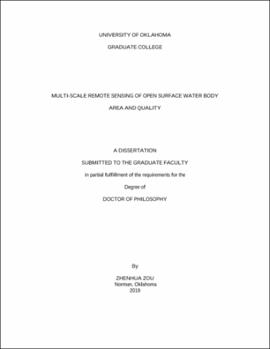| dc.description.abstract | Water is one of the most important resources for life. Climate change and climate variability have caused dramatic variations and significant trends in surface water resources, while global population growth and increased food demand have greatly stressed and modified global surface water systems. These changes in surface water resources have huge consequences to human society, natural environment, and global biodiversity. Landsat satellites have scanned the entire earth in every 16 days since the 1980s. The historical information of surface water body spatial distribution, temporal variation, and multi-decadal trends documented in remote sensing images can aid in water resource research, planning, and management, yet it is not well explored. This dissertation aims to develop algorithms and generate open surface water body maps at state, national, and global scales. Based on these maps, the interannual variations and long-term trends of surface water body area were analyzed while their climatic and anthropogenic drivers were examined. The joint analysis of both surface water body area and land water storage was carried out to explore the consistency and divergence between surface and land water resource dynamics. The potential of satellite images in water chlorophyll-a concentration estimation was also evaluated. Chapter 2 used ~16,000 Landsat images to analyze surface water body dynamics in Oklahoma and found significant decreasing trends in both surface water body area (the maximum, year-long, seasonal, and average water body area) and water body number (maximum and year-long water body numbers) during 1984–2015. The decrease of water body area was mainly attributed to the shrinking of large water bodies (>1 km2) while the decrease in water body number was mainly caused by the vanishing of some small water bodies. Smaller water bodies have a higher risk of drying up under climate-warming scenarios. Chapter 3 used ~ 370,000 Landsat images and the Gravity Recovery and Climate Experiment (GRACE) land water storage data to analyze changes in surface water area and groundwater across the contiguous US (CONUS) during 1984–2016. Divergent trends of surface water area were found across the CONUS with water-poor regions of the Southwest and Northwest US getting poorer, while the water-rich regions of the Southeast US and far north Great Plains getting richer. In the 2012-2014 prolonged droughts, surface water body shrinkage had led to massive groundwater mining and the rapid decline of land water storage in California and the Southern Great Plains. Chapter 4 used ~3.8 million Landsat images and GRACE land water storage data to analyze surface water area and land water storage jointly during 1984–2017 at 0.01° grid cells, 0.5° grid cells, and 5° tiles across the globe. About 8.5 million 0.01° grid cells had significant increasing or decreasing trends in surface water area over the past decades, forming interesting spatial patterns in northern Greenland, Tibetan Plateau, western US, the Great Lakes, Gulf of Bothnia, central South America, etc. The interannual variations, magnitude of variability, and the multi-decadal trends of regional surface water area were analyzed and visualized at 5° tiles. Divergent trends between land water storage and regional surface water area occurred in Greenland, China, the Indus Basin, and central Africa, mainly driven by climate and anthropogenic activities. Chapter 5 used ~10,000 chlorophyll-a field measurements to evaluate the potential of Landsat 5/7/8 and Sentinel 2 satellite images in water chlorophyll-a content estimation. Regression models of Landsat data have different performance in various water sampling sites and water bodies across Oklahoma, with relatively good performance in Eufaula Lake, Keystone Lake, Copan Lake, Hugo Lake, Foss Reservoir, and Atoka Reservoir. The brightness temperature band of Landsat satellites showed great potential in chlorophyll-a estimation, which indicated that temperature was among the most important factors of algal blooms in Oklahoma. The Red Edge 2 band of Sentinel 2 Satellite also showed great potential in chlorophyll-a estimation among different water sampling sites and water bodies across Oklahoma. The findings in this dissertation can be used in water resource research, planning, and management in coping with water scarcity and food security associated with climate change and population growth. | en_US |
